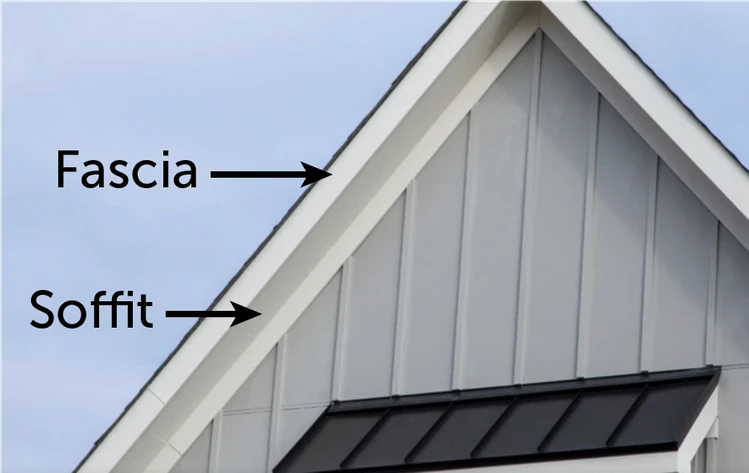
Many homeowners underestimate the labor and material cost of installing soffit and fascia on their homes. Though these two elements seem like small parts of the exterior, they are absolutely essential. Any damage should be addressed immediately, as both soffit and fascia add aesthetic and protective value to the structure.
The labor cost to install soffit and fascia can vary greatly depending on the type of material used and how frequently you need to replace it. For that reason, it’s best to install a durable, long-lasting material, like fiber cement, which is known to be more durable and poses fewer risks than wood and vinyl, which are both quite susceptible to damage.
Either way, understanding the average labor cost to install soffit and fascia can be a great start to determining the long-term value of more modern materials. In this article, we’ll explore the important factors that affect soffit and fascia costs so you can choose the right product for your home.
Why Soffit and Fascia Replacement is Important
The roles of soffit and fascia are often overlooked, but these two elements are absolutely vital to having a home with a clean, attractive appearance that is also well protected from the elements. It’s also important to know which is which so you can calculate the cost of repairs more precisely.

Fascia sits vertically on the edge of the roof end and creates a smooth seal between the soffit and the roof. Soffit, on the other hand, covers the underside of the roof overhang or the eaves. Though soffit sits beneath the overhang, it still provides great aesthetic value by covering the exposed beams and creating a more attractive finish.
However, soffit has another role beyond aesthetics. Vented soffit adds valuable ventilation to keep the attic space at an ideal temperature. This benefit is important for the overall energy efficiency of your home, as well as the ability to keep ice from forming on the roof that could lead to moisture or structural damage.
Since soffit and fascia add to the overall curb appeal of the home and help with ventilation, it is essential to maintain them. Any signs of grime or mold growth should be cleaned immediately, and more serious damage should be addressed with repairs and replacement panels.

Signs You Need New Soffit or Fascia
When it comes to soffit and fascia, there are certain signs of damage and deterioration that should ring alarm bells in your mind. Any bent sections or loosened seams that create noticeable gaps between the soffit or fascia should warrant immediate concern. After all, soffit and fascia function very much like a lid — they seal off access to the attic and interior walls so that moisture and critters can’t get in. When these panels become misshapen or loose, they compromise that seal, increasing the risk of more serious damage.
Though broken or bent sections are some of the most concerning types of damage, there are other signs you should look for that might require repairs or replacements. For example, mold or mildew growth, rotten boards, and color fading are all signs it’s time to install fresh fascia and soffit.
In reality, the type of damage — and its severity — is often linked to the building material. Weaker materials, like wood and vinyl, often cause much more damage than modern soffit and fascia materials with enhanced durability.
Material Costs to Install Soffit and Fascia in 2024
Deterioration and the need for replacement are important to consider because they will directly impact the long-term value and cost of installing soffit and fascia. Upfront material costs are one thing — but materials that are likely to accrue more damage and need replacement sooner are never a good investment.

For example, wood and vinyl tend to be more affordable when it comes to material costs, with wood averaging $1-$3 per linear foot and vinyl averaging $5-$8 per linear foot. Aluminum is a wild card with a vast range of material costs, averaging anywhere from $8-$20 per linear foot of fascia or soffit. Fiber cement is slightly more than wood and vinyl but less than aluminum, averaging $5-$13 per linear foot.
How Much Does it Cost to Install Soffit and Fascia?
When looking at the labor cost to install soffit and fascia, it can be tricky to compare as they depend heavily on the contractor and materials available. Generally, you can assume the soffit and fascia labor costs will differ.
Sofft installation costs should fall between $1.50-$4 per linear foot, and fascia installation costs should fall between $6-$20 per linear foot. As a result, the average cost to install soffit and fascia should fall between $7.50-$24. Those same prices apply to all material costs, including labor cost to install aluminum soffit and fascia.
Again, those soffit and fascia installation costs can differ depending on your contractor and the type of materials you’re using, so don’t assume anything about the cost to install soffit and fascia. Speak with a professional contractor to learn more about the cost of soffit and fascia installation.
Fiber Cement from Allura is the Right Choice for Long-Lasting and Durable Soffit and Fascia
Though wood or vinyl may seem like a better deal because of their low material costs, it’s important to remember how damage-prone they are. Both wood and vinyl are highly flammable and prone to color fading and moisture damage, leading to warping and mold growth. Thus, they are likely to require repairs down the line.
Compare that with the high durability of fiber cement, which is weather resistant and built to last, and it’s clear to see that fiber cement has better long-term value. Plus, there are a ton of styles available with fiber cement soffit and fascia, so you can personalize the look of your home’s exterior.
Contact Allura today to explore an exciting range of fiber cement products with excellent lifetime value.




